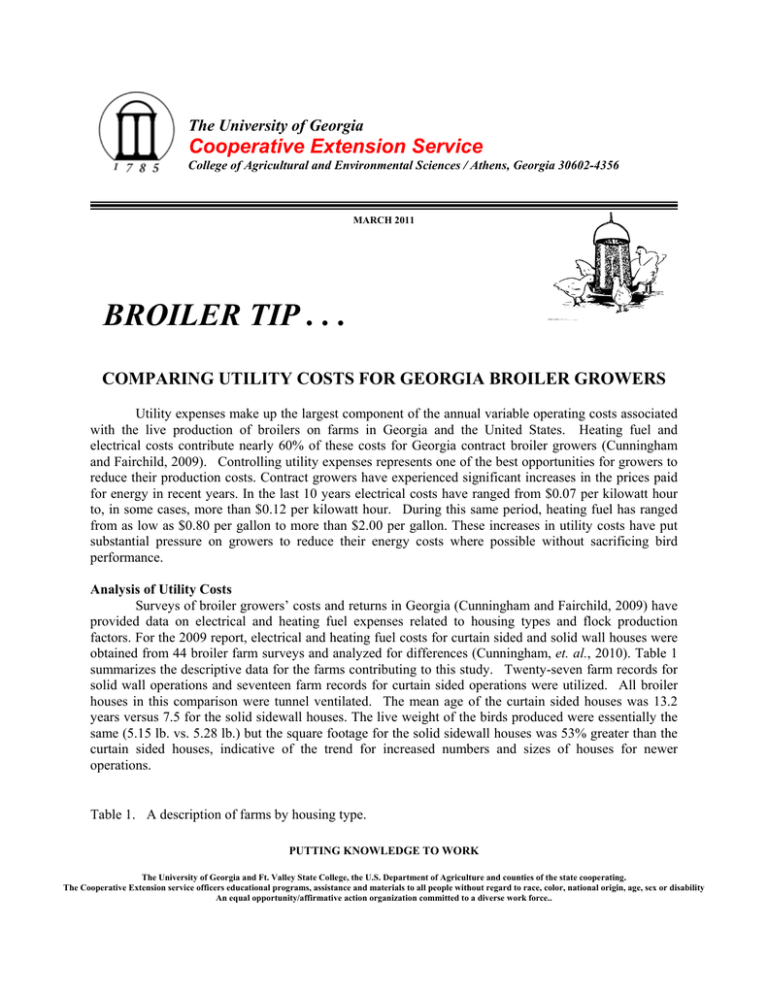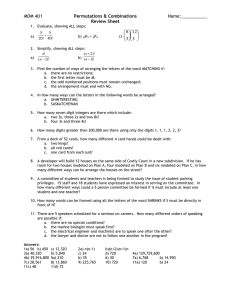BROILER TIP . . . Cooperative Extension Service The University of Georgia
advertisement

The University of Georgia Cooperative Extension Service College of Agricultural and Environmental Sciences / Athens, Georgia 30602-4356 MARCH 2011 BROILER TIP . . . COMPARING UTILITY COSTS FOR GEORGIA BROILER GROWERS Utility expenses make up the largest component of the annual variable operating costs associated with the live production of broilers on farms in Georgia and the United States. Heating fuel and electrical costs contribute nearly 60% of these costs for Georgia contract broiler growers (Cunningham and Fairchild, 2009). Controlling utility expenses represents one of the best opportunities for growers to reduce their production costs. Contract growers have experienced significant increases in the prices paid for energy in recent years. In the last 10 years electrical costs have ranged from $0.07 per kilowatt hour to, in some cases, more than $0.12 per kilowatt hour. During this same period, heating fuel has ranged from as low as $0.80 per gallon to more than $2.00 per gallon. These increases in utility costs have put substantial pressure on growers to reduce their energy costs where possible without sacrificing bird performance. Analysis of Utility Costs Surveys of broiler growers’ costs and returns in Georgia (Cunningham and Fairchild, 2009) have provided data on electrical and heating fuel expenses related to housing types and flock production factors. For the 2009 report, electrical and heating fuel costs for curtain sided and solid wall houses were obtained from 44 broiler farm surveys and analyzed for differences (Cunningham, et. al., 2010). Table 1 summarizes the descriptive data for the farms contributing to this study. Twenty-seven farm records for solid wall operations and seventeen farm records for curtain sided operations were utilized. All broiler houses in this comparison were tunnel ventilated. The mean age of the curtain sided houses was 13.2 years versus 7.5 for the solid sidewall houses. The live weight of the birds produced were essentially the same (5.15 lb. vs. 5.28 lb.) but the square footage for the solid sidewall houses was 53% greater than the curtain sided houses, indicative of the trend for increased numbers and sizes of houses for newer operations. Table 1. A description of farms by housing type. PUTTING KNOWLEDGE TO WORK The University of Georgia and Ft. Valley State College, the U.S. Department of Agriculture and counties of the state cooperating. The Cooperative Extension service officers educational programs, assistance and materials to all people without regard to race, color, national origin, age, sex or disability An equal opportunity/affirmative action organization committed to a diverse work force.. House Type Curtain Sided Solid Sidewall # of Farms 17 27 Mean Age 13.2 7.5 Mean Weight 5.15 lb. 5.28 lb. Mean Ft/farm 68,052 104,178 Total Sq. Ft. 1,156,884 2,812,806 Electrical Costs Analysis of the electrical costs data found no significant differences for costs between curtain and solid sidewall houses (Table 2.) The mean electrical cost for the curtain sided houses was $0.0211/ sq. ft. / flock compared to $0.0248/ sq. ft. /flock for the solid sidewall houses. For a 20,000 sq. ft. house, this translates into an annual cost of $2,532 and $2,976 for the curtain and solid walled houses respectively; a difference of only $444. These results suggest that both types of tunnel ventilated houses can be operated with similar electrical efficiencies if designed, constructed and managed properly. Table 2. Electrical costs by housing type. House Type Curtain sided Solid sidewall Difference $/Ft/flock 0.0211 0.0248 0.0037 CV* 42% 35% 7% Cost/20,000 Ft $2,532 $2,976 $444 *Coefficient of variation The coefficient of variability (CV) is a statistical measurement of data variability. The larger the CV the greater the differences among members of a sample group for the data collected. Thus, the larger the CV the less uniformity among the farms sampled. The coefficients of variability for electrical usage were relatively high (42% and 35%) indicating a wide range in electrical usage regardless of house type. The ranges of annual electrical costs for farms in the study were from $1,620 per 20,000 sq. ft. to $5,148 per 20,000 sq. ft. for curtain sided houses and $1,716 to $5,424 per 20,000 sq. ft. for solid sidewall houses. This large variability among farms strongly suggests that, regardless of house type and growing conditions, growers with electrical usage toward the high end of the range could likely improve their bottom line profitability by improving their ventilation methods. Some suggested areas for grower attention to reduce electrical usage are: Clean fans, shutters and screens Replace burned out motors with energy efficient motors Perform routine cleaning and maintenance on evaporative cooling pads Replace incandescent light bulbs with more energy efficient compact fluorescent bulbs Propane Usage and Cost Solid wall houses used less propane (.0265 gal/sq. ft. per flock vs. .0361 gal/sq. ft. per flock) compared to curtain houses (Table 3.). These results were highly significant and were expected given the differences between insulation values of curtain and solid sidewall houses. On average, solid sidewall houses used $2,146 less fuel per 20,000 sq. ft. than curtain sided houses. For a typical four-house farm this represents a saving of more than $8,500 per year. PUTTING KNOWLEDGE TO WORK The University of Georgia and Ft. Valley State College, the U.S. Department of Agriculture and counties of the state cooperating. The Cooperative Extension service officers educational programs, assistance and materials to all people without regard to race, color, national origin, age, sex or disability An equal opportunity/affirmative action organization committed to a diverse work force.. Table 3. Propane usage and costs by housing type. House Type Gal/ft./flock CV* 0.0361 0.0265 0.0076 23% 30% 7% Curtain sided Solid sidewall Difference Gal Used/ 20,000 ft./Year 4,332 3,180 1,152 Cost/ 20,000 ft./year $8,049 $5,903 $2,146 *Coefficient of variation. The CVs for propane usage (23% and 30%) were not as large as for electrical costs but were large enough to suggest that broiler growers could benefit from attention to house conditions and brooder management for both types of houses. The following are some suggestions for improving fuel usage in broiler houses: Minimize air leakage with tighter curtains and door seals Conduct routine static pressure test to determine house tightness Use circulation fans Consider installing insulated tunnel doors Use litter treatments for ammonia control Consider installing attic inlets Keep darkling beetles under control to reduce insulation damage Analysis of utility costs among Georgia broiler growers participating in this study indicates substantial differences in propane usage and costs between housing types. On average, solid sidewall houses used 1,152 gallons less propane per 20,000 sq. ft. resulting in a cost saving of $2,146 per year. In addition, the coefficients of variability for both electrical usage and propane costs were relatively high, indicating large variations in performances for all housing types. This large variation among farms suggests that regardless of housing type, many growers could likely improve their bottom-line profitability with improved management programs. More detailed information on management programs to improve efficiencies and suggested references are available in the full report (Cunningham et. al., 2010). References Cunningham, D. L. and B. D. Fairchild, 2009. Broiler production systems in Georgia: Costs and returns analysis. UGA Department of Poultry Science Bulletin # 1240 (www.poultry.uga.edu). Cunningham, D. L., B.D. Fairchild and M. Czarick III, 2010. An analysis of utility costs for Georgia broiler growers. UGA Department of Poultry Science Bulletin #1375 (www.poultry.uga.edu). Dan L. Cunningham Extension Poultry Scientist Extension County Agent/Coordinator “Your local County Extension Agent is a source of more information on this subject.” PUTTING KNOWLEDGE TO WORK The University of Georgia and Ft. Valley State College, the U.S. Department of Agriculture and counties of the state cooperating. The Cooperative Extension service officers educational programs, assistance and materials to all people without regard to race, color, national origin, age, sex or disability An equal opportunity/affirmative action organization committed to a diverse work force..



